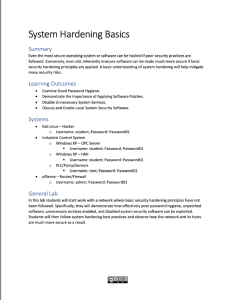System Hardening Basics Scenario

This collection of resources, from the Cybersecurity Education for Advanced Manufacturing Organizations project, is part of the System Hardening Basics Scenario. This scenario is a cybersecurity training module designed to introduce and reinforce essential practices for securing systems. The scenario emphasizes the importance of system hardening, which involves implementing best practices and maintaining good security hygiene to enhance system security.
Collection Contents:
This scenario includes a PowerPoint presentation, a lab overview, a lab, lab questions and answers, and a document with links to related videos. The presentation outlines key objectives, including discussing system hardening, examining good password hygiene, demonstrating the importance of applying software patches, disabling unnecessary system services, and enabling local system security software. The use of passphrases for better security, advising against common phrases, and suggesting the inclusion of punctuation and spaces is emphasized. Additionally, the presentation highlights the benefits of disabling unnecessary services, such as reducing the attack surface and improving system performance.
The 3-page lab overview includes a summary, learning outcomes, a list of systems used, a description of the general lab, a diagram of setup and deploy, and a list of resources for more information. During the lab, students "... work with a network where basic security hardening principles have not been followed." Students "... will demonstrate how effectively poor password hygiene, unpatched software, unnecessary services enabled, and disabled system security software can be exploited. Students then implement system hardening best practices and observe the resulting increased security of the network and its hosts. PDF and Word versions are included.
The 11-page lab includes a scenario overview and lab instructions. Some of the main steps of the lab include installing systems, working with insecure passwords, exploiting vulnerabilities, disabling unnecessary services, verifying security measures, and document findings. PDF and Word versions are included.
The 2-page lab form questions include questions about password security, the use of brute force attacks, and the importance of software patches. Additionally, this document asks participants to provide screenshots demonstrating the removal of unnecessary services and the enabling of a host firewall. A 3-page answer sheet is also provided. Both documents include PDF and Word versions.
For orientation purposes the hardening-Overview.pdf is included as a separate attachment and offers a sample of the type of material included in this learning module.
Below is a list of the files contained within the .zip attachment. The size of each file is included in parenthesis.
hardening-ate (13 files, 8.2 MB)
- Systems Hardening Basics (hardening-Background.pdf 487 KB)
- Systems Hardening Basics (hardening-Background.pptx 3 MB)
- Systems Hardening Lab Form (hardening-Lab-Answers.doc 434 KB)
- Systems Hardening Lab Form (hardening-Lab-Answers.pdf 289 KB)
- Systems Hardening Lab Form (hardening-Lab-Form.doc 46 KB)
- Systems Hardening Lab Form (hardening-Lab-Form.pdf 128 KB)
- System Hardening Basics (hardening-lab.docx 2.5 MB)
- System Hardening Basics (hardening-lab.pdf 699 KB)
- System Hardening Basics (hardening-Overview.docx 337 KB)
- System Hardening Basics (hardening-Overview.pdf 240 KB)
- Video Links (hardening-Videos.docx 14 KB)
- Video Links (hardening-Videos.pdf 21 KB)
About this Resource

Comments